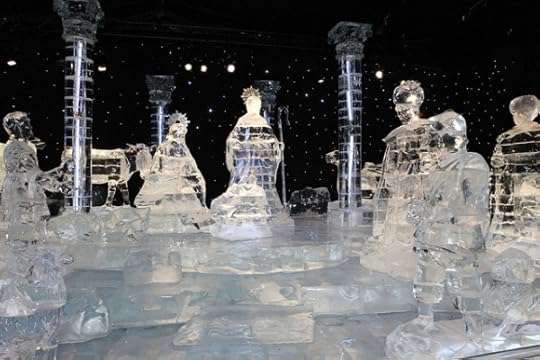Andrew Sullivan's Blog, page 402
December 24, 2013
A Very John Waters Christmas
In an excerpt from Crackpot, the twisted director shares his favorite films of the season:
Forget White Christmas, It’s a Wonderful Life and all the other hackneyed trash. Go for the classics: Silent Night, Bloody Night, Black Christmas or the best seasonal film of all time, Christmas Evil (“He’ll sleigh you”). This true cinematic masterpiece only played theatrically for a few seconds, but it’s now available on videocassette and no holiday family get-together is complete without it.
It’s about a man completely consumed by Christmas. His neurosis first rears its ugly head as he applies shaving cream to his face, looks in the mirror, hallucinates a white beard and begins to imagine that he is Santa Claus. He gets a job in a toy factory, starts snooping and spying on the neighbourhood children and then rushes home to feverishly make notes in his big red book: “Jimmy was a good boy today,” or “Peggy was a bad little girl.” He starts cross-dressing as Claus and lurks around people’s roots ready to take the plunge. Finally, he actually gets stuck in a nearby chimney and awakens the family in his struggle. Mom and Dad go insane when they find a fat lunatic in their fireplace, but the kids are wild with glee. Santa has no choice but to kill these Scroogelike parents with the razor-sharp star decorating the top of their tree. As he flees a neighbourhood lynch mob, the children come to his rescue and defy their distraught parents by forming a human ring of protection around him. Finally, pushed to the limits of Clausmania, he leaps into his van/sleigh and it takes off flying over the moon as he psychotically and happily shrieks, “On Dancer! On Prancer! On Donner and Vixen!”
I wish I had kids. I’d make them watch it every year and if they didn’t like it, they’d be punished.



Face Of The Day
Vincent Herman waits in line during the Father Woody money giveaway at the Cathedral Basilica of the Immaculate Conception in Denver, Colorado. Herman said, “I’m having a rough time trying to find a job, this is great.” More than 1,000 people, some of them homeless, all of them struggling, circled a Capitol Hill block Friday morning, waiting in the gray, freezing cold so they could pocket $20 in an annual Christmas event started by the late Monsignor Charles B. Woodrich. By Craig F. Walker/The Denver Post/Getty.



The Misery Of Materialism
Just in time for the very last round of Christmas shopping, George Monbiot has issued a cri de coeur against consumerism. He notes that there “has long been a correlation observed between materialism, a lack of empathy and engagement with others, and unhappiness”:
[A] series of studies published in the journal Motivation and Emotion in July showed that as people become more materialistic, their wellbeing (good relationships, autonomy, sense of purpose and the rest) diminishes. As they become less materialistic, it rises. In one study, the researchers tested a group of 18-year-olds, then re-tested them 12 years later. They were asked to rank the importance of different goals – jobs, money and status on one side, and self-acceptance, fellow feeling and belonging on the other. They were then given a standard diagnostic test to identify mental health problems. At the ages of both 18 and 30, materialistic people were more susceptible to disorders. But if in that period they became less materialistic, they became happier. …
Another paper, published in Psychological Science, found that people in a controlled experiment who were repeatedly exposed to images of luxury goods, to messages that cast them as consumers rather than citizens and to words associated with materialism (such as buy, status, asset and expensive), experienced immediate but temporary increases in material aspirations, anxiety and depression. They also became more competitive and more selfish, had a reduced sense of social responsibility and were less inclined to join in demanding social activities. The researchers point out that, as we are repeatedly bombarded with such images through advertisements, and constantly described by the media as consumers, these temporary effects could be triggered more or less continuously.



Mental Health Break
Festive Foliage
Americans prefer real Christmas trees to artificial ones:
Rick Dungey, of the NCTA [National Christmas Tree Association], dismisses the artificial sort as “plastic tree-shaped decorations”. Americans tend to agree, buying more real trees than fake ones. Of 35m sold every year, 70% sprout from the ground. Despite a rise in sales a decade ago, fake trees have lost their sparkle since the financial crisis. But according to the American Christmas Tree Association, a trade group that claims to represent both types of tree, 83% of homes have a fake shrub.
Leslie Horn insists on authenticity:
[U]nless you’re a slight scrooge or suffer from severe seasonal allergies, you must go with the real thing. Douglas Fir, Blue Spruce, Scotch Pine—pick your pleasure. The smell is part of the fun, and car air fresheners or kitchen candles just don’t give the same seasonal effect.
Last year, Timothy Taylor reviewed research on how real and artificial trees affect the environment:
One artificial tree has greater environmental impact than one natural tree. However, an artificial tree can also be re-used over a number of years. Thus, there is some crossover point, if the artificial tree is used for long enough, that its environmental effect is less than an annual series of trees. For example, the [2009] ellipsos study [pdf] finds that an artificial tree would need to be used for 20 years before its greenhouse gas effects would be less than those of an annual series of natural trees.
Taylor considers other factors:
[T]he environment effect of the ornaments on the trees may be as large or greater than the effect of the tree itself. Data from the U.S. Census Bureau shows that America imported $1 billion in Christmas tree ornaments from China (the leading supplier) between January to September 2012, but only $140 million worth of artificial Christmas trees. Thus, spending on ornaments is something like six times as high as spending on [artificial] trees. The choice of what kind of lights on the tree, or whether to drape the house and front yard with lights, is a more momentous environmental decision than the tree itself.
Previous Dish on Christmas trees here and here.



It’s The Cash That Counts
According to a NSFW parody of a Christmas classic:
Derek Thompson weighs in:
Cash is the most efficient gift, according to economists. Cash is also a terrible gift, according to economists. By guaranteeing that the recipient can buy exactly what she wants, you guarantee that the recipient will consider you an unemotional robot.
That’s why the vast majority of economists in the University of Chicago’s IGM poll said it’s absurd to give cash to loved ones for the holidays. ”In some cases,” Steven Kaplan said, in a stirring defense for thoughtful gifts, “non-pecuniary [not cash-related] values are important.”



The 2013 Dish Awards: The Malkin Award
It’s a close race for the prize, which is given “for shrill, hyperbolic, divisive and intemperate right-wing rhetoric.” As of this writing, Rep. Steve Stockman (R-TX) is narrowly ahead, earning 29.36% of the vote for this rant:
Democrats do not want abortion to be safe or rare. Democrats oppose even the most basic of health and safety standards for abortion mills. Democrats don’t care how many women are maimed, infected with diseases or die on the routinely-filthy abortion mills. Democrats worship abortion with same fervor the Canaanites worshipped Molech.
About a point behind, with 28.09%, is Richard Cohen, who was nominated for his infamous column on Bill de Blasio:
People with conventional views must repress a gag reflex when considering the mayor-elect of New York — a white man married to a black woman and with two biracial children. (Should I mention that Bill de Blasio’s wife, Chirlane McCray, used to be a lesbian?)
Who deserves highest dishonors? Review all the candidates and decide here. Use the links below to vote for the other awards.
Click here to vote for the 2013 Moore Award!
Click here to vote for the 2013 Dick Morris Award!
Click here to vote for the 2013 Poseur Alert!
Click here to vote for the 2013 Yglesias Award!
Click here to vote for the 2013 Hewitt Award!
Click here to vote for the 2013 Hathos Alert!
Click here to vote for the Chart Of The Year!
Click here to vote for the Cool Ad Of The Year!
Click here to vote for the Face Of The Year!
Click here to vote for the Mental Health Break Of The Year!
Click here to vote for the Window View Of The Year!



December 23, 2013
Last-Minute Christmas Shopping: Give The Gift Of The Dish!
[Updated and re-posted from the weekend]
A new gift-giver writes:
Glad to be able to provide a gift subscription for my 23-year-old daughter. I am another of those people whose is always bringing the phrase “Andrew says this” to every political, spiritual or current events discussion at our house. I didn’t realize that I was being heard until about a month ago. I usually check The Dish every day, while eating lunch or – embarrassed to admit but seems fair given previous discussion on the site – while “dropping the kids at the pool.” I don’t miss an entry. I had a very busy day at work a few weeks back and would have missed your posting of my view from my window had my daughter not recognized her own backyard. I didn’t realize she had become a daily reader – although free rider. I owe her – and you all, given how much I have gotten from the site – a gift subscription for her.
In case you missed the details: Tinypass, our e-commerce partner, just released an updated version of our gifting service, in time for Christmas. Now you can schedule the delivery of a gift subscription to the day. Just buy it now and have it automatically emailed to your friend or family member on Christmas Day. You can also add a personalized message. Just go here to fill out a quick form for a one-year gift subscription – which, remember, is a one-time purchase that won’t recur next year. The price is just $19.99 – or more if you want to give a little extra to the Dish this year. Another gift-giver writes:
I’m a long-time reader and was an early and enthusiastic subscriber, but it wasn’t until I read and listened to the latest Deep Dish that I finally got off my butt to send several gift subscriptions to friends who I know will just LOVE the essay on Pope Francis and the wide-ranging conversation with Dan Savage. It was really self-interest on my part – this volume of Deep Dish is provoking so many thoughts and ideas that I need smart people to talk to about it all! What better way, I figured, than to give gift subscriptions to some of my smart, thoughtful friends? I hope other Dish heads are feeling so inspired – it’s such an easy gift (takes no time at all!), for a friend and for the Dish.
Another:
I just sent gift subscriptions to my cousin and aunt in North Yorkshire, the few relatives of mine who love politics as much as I do. I am Canadian and don’t get to talk to or visit my British relatives all that much, so I am hoping your blog will bring us a little closer.
Another:
I’ve just purchased two gift subscriptions. One for my father, one for my brother. These two people are the ones who were most responsible for my own intellectual and worldview development as I was growing up, and I couldn’t be happier to share back with them my favorite daily source of intellectual exercise – the Dish.
And finally, if you’re one of our 35,000 Dishhead free-riders who maxed out the meter but haven’t subscribed yet, why not give yourselves and us a present? Subscribe here for as little as $1.99 a month. From a recovering free-rider:
Sigh. I finally gave in, and subscribed today, after resisting right from the beginning of the year – not out of procrastination, but for philosophical reasons.
I realised that I’ve been reading The Dish since 2004, that it was one of the blogs that kept me sane during the Bush years, that it helped me adjust to American life significantly (like Andrew, I am a British person born in the early sixties, Oxbridge educated, came to maturity during the Thatcher years, met and fell in love with an American, and moved here ten years ago). Since that time, I’ve read The Dish several times a day, and it’s been one of the bookmarks on my web browser/mobile phone browser that always gets transferred straight away from device to device. And yet I felt unwilling to fork over the modest sum of just under twenty dollars a year when asked to fund the new venture.
Why? Because, wonderful as it is, The Dish’s marvelous commentary is still largely based on stories that originate elsewhere. It’s like the best opinion page on the planet, but if I wasn’t paying for the news sources that dig up those stories in the first place, it didn’t seem right to spend the money on a blog either. Well, one solution is to pay for both, which I have done (New York Times is getting a subscription, too).
The main reason that made me change my mind is, quite simply, Deep Dish. Longer pieces that are related to the blog but more closely resemble magazine journalism, e-books like the Iraq War penance – that is absolutely worth paying for.
Finally, you’ve heard this many times before, but it’s the fact that I don’t always agree with you that keeps me coming back. You’ve created a unique space on the Internet, and I am now happy to contribute a little cash to keep it going.



Christmas On Display
David Kyle Johnson traces the legal history:
The first Supreme Court case regarding Christmas displays was in 1984, with another in 1989. In short, the Court ruled that government Christmas displays are unconstitutional if they endorse or convey a religious message. This produced the “Reindeer Rule”, which called for equal representation for non-religious Christmas symbols. Consequently, to avoid legal battles, many local governments erect secular decorations along with their crèche; others simply open up a public space for anyone to display their holiday decoration of choice. While others just pay lip service to the rule, erecting only small Mr. and Mrs. Santa Clauses far behind the crèche, still, others ignore the rule entirely. This year, a few southern states have even passed or proposed “Merry Christmas Laws” that directly contradict the Court’s rulings. The battle continues.
To be fair, of course, not all Christians are unfamiliar with the factual history of Christmas and America’s founding, but not all Christians like courthouse nativities. They recognize the need for church/state separation, and object to such displays for the same reason as seculars and non-Christians. Nativities are for display at a church, and at a Christian’s home—not the Courthouse.
(Photo of nativity scene made of ice by Sam Howzit)



Casual Cachet
Francesca Gino explains how underdressing can actually increase perceived social status:
In recent research, my Harvard Business School colleagues Silvia Bellezza and Anat Keinan and I found that under certain conditions, nonconforming behaviors, such as not following the expected dress code or the appropriate professional conduct in a given context, can signal higher status. In our research, for example, shop assistants working in boutiques selling luxury brands in Milan assigned greater status to the woman wearing gym clothes and a jean jacket rather than to the woman properly dressed. In another study, students assigned higher status to a 45-year-old professor working at a top-tier university when he was described as wearing a t-shirt and had a beard than to a clean-shaven one wearing a tie. When the deviant behavior appears to be deliberate, it can lead to higher status inferences rather than lower ones.
Why is this the case? Nonconformity often has a social cost, so people assume people breaking the rules enjoy a powerful enough position that they are not concerned about the costs.



Andrew Sullivan's Blog
- Andrew Sullivan's profile
- 154 followers








